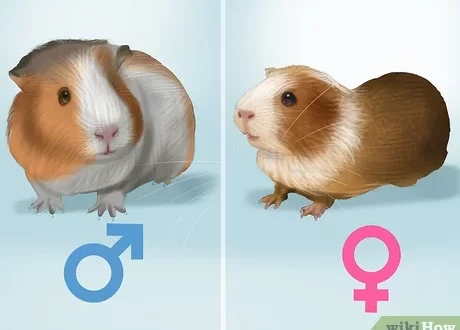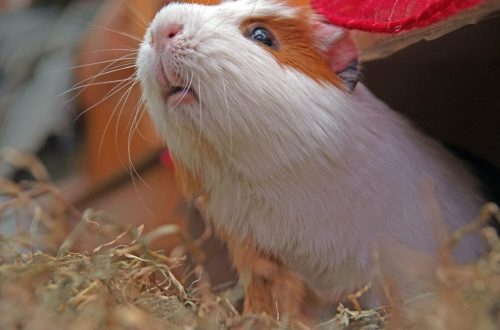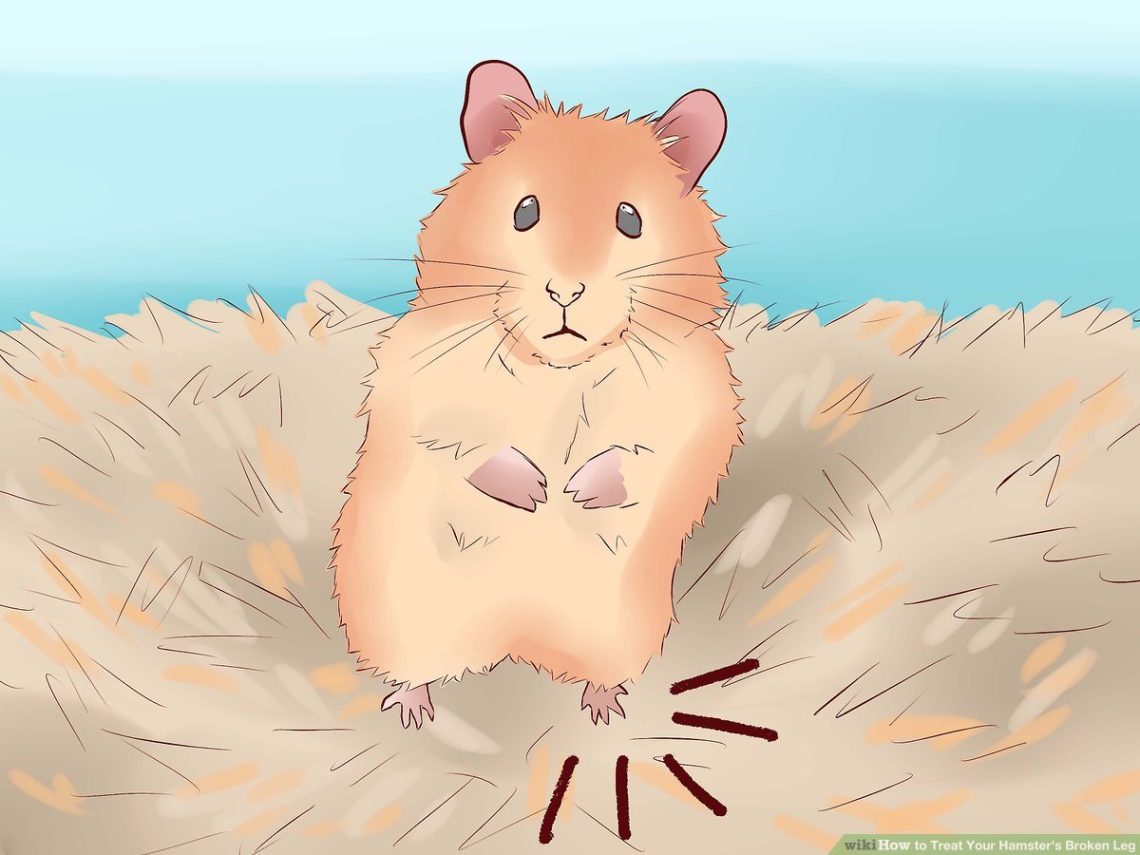
What to do if a hamster broke a paw, symptoms and treatment of paw fractures
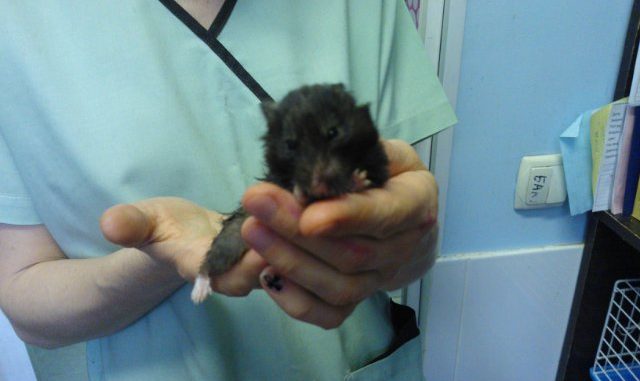
Caged hamsters are prone to injury. The animals are careless, they can fall off the table or sofa while walking. Hamsters are dropped from hands, especially if the pet bites or breaks out. But most often, the bars of the cage and the running wheel of an inappropriate design become the cause of damage to the limbs. Hamsters love to climb the walls and ceiling of the cage. If one leg gets stuck between the bars, then hanging on it with all its weight and trying to free itself, the animal increases the injury. Therefore, each owner must imagine what to do if the hamster broke his paw.
Contents
Signs of a fracture
Minor injuries (bruises, sprains) often go unnoticed. To understand that a rodent has injured its leg, you can only let it out for a walk. In a cage it is difficult to say whether the pet is lame. The hamster hides in the house, activity decreases, and after a couple of days he behaves as if nothing had happened.
If the stuck pet only slightly injured the skin, the abrasion is washed with an antiseptic and heals quickly.
But when a hamster’s leg is broken, it’s impossible not to notice. The limb is very swollen, can be twisted at an unnatural angle, dragging when walking. With a closed fracture there will be a hematoma (purple or blue paw), with an open fracture – a wound and bleeding, a damaged bone is visible.
Diagnostics
Do not try to feel the fracture. Even a specialist in a veterinary clinic should not do this: the bones of rodents are too thin to assess their condition with your fingers. It makes no sense to cause additional suffering to the animal.
Modern digital x-rays make it possible to see a fracture even in the smallest animals. If the injury is obvious, the owner often doubts the need to take an X-ray – after all, it is already clear that the hamster has broken its paw. Pictures are needed in order to distinguish a fracture from a dislocation, as well as to get a complete picture of the injury. Without this, it is difficult to give a prognosis and prescribe treatment.
Caring for a hamster with an injury
With a closed fracture, owners rarely take their hamster to the clinic. They are right in their own way: regardless of the type of injury, if there is no damage to the skin, wounds, the care will be the same
Mobility restriction
The hamster is transplanted into a small plastic carrier for a period of 2 weeks. They are not allowed out for walks.
For lack of carrying, use an ordinary plastic bucket, basin or deep container.
If it is not possible to transplant the victim from the lattice cage, then remove all toys (wheel, tunnels), ladders, second floor.
The litter is replaced with scraps of napkins so that the animal stops digging and digging.
Dosed feeding
If the front paw is damaged, the hamster should not be allowed to stuff the cheek pouches. It will be difficult for a rodent to get food out of there on its own, and inflammation will occur. The grain mixture in a small bowl will help keep the cage clean. Be sure to provide a complete and balanced diet for the hamster. Peace is all a pet needs.
A closed leg fracture in a hamster does not result in death, although lameness often remains if the bones have not healed properly. The situation is different if the injury is more serious – an open fracture.
Open fracture
A broken bone is sometimes damagedgives muscle and skin at the time of injury. In this case, there will be a wound on the foot – a small one. or extensive, in which the bone is visible. The paw is bleeding.
If it is not possible to deliver the rodent to the veterinarian, first aid is provided at home. Restriction of movement, as in the case of a normal injury. It is almost impossible to protect a wound from infection, but every effort must be made to do this. Otherwise, purulent inflammation, gangrene, and sometimes even sepsis (blood poisoning) occur.
Caring for a hamster with an open fracture
The risk of infection is very high. An Elizabethan collar is not worn on rodents, so nothing will stop a hamster from licking the wound. Their saliva is not healing, but on the contrary, it contains a lot of dangerous microbes. Bedding, food, and even feces get into the wound and heavily pollute it.
Daily wound treatment with antiseptic (2-4 times a day)
Use chlorhexidine, miramistin, an aqueous solution of furacilin. Rinse thoroughly, under pressure. It is convenient to use a plastic syringe without a needle. A warm solution causes less discomfort, so the medicine is not stored in the refrigerator and is additionally warmed before the procedure.
Ointments are not used on a fresh wound (Levomekol, Synthomycin emulsion), but they can be useful in case of purulent inflammation. Powders (Baneocin, Streptocid) are not prescribed for extensive wounds, as they contribute to the formation of a crust and the development of infection under it.
If the hamster broke its paw a few days ago, and it has already festered, systemic antibiotics are used – injections of baytril, enroxil or ordinary human bicillin-3, diluted with water for injection.
Keeping the cage clean
Sawdust bedding is replaced with scraps of paper napkins. Changed daily so that feces do not accumulate. Food is given in the feeder, in small portions, so that the animal does not stock up.
What NOT to do with fractures in a hamster
Consider what actions in case of a broken paw in a hamster not only do not have a therapeutic effect, but only worsen the problem.
Giving calcium and unusual foods
Excess calcium in the diet does not accelerate the healing of the fracture, but it puts a significant burden on the kidneys. Advice to drink calcium gluconate, give calcium tablets to gnaw, are not justified. It is unacceptable to introduce dairy products (cottage cheese, kefir) into the diet if the homa has not tried them before. It is much easier for a hamster to die from indigestion than from a fracture.
Apply plaster
If a specialist in a veterinary clinic offers to fix a limb, this means that he is used to working with cats and dogs, and not with rodents.
Reasons why hamsters don’t get a splint on a broken leg
External fixation will not only not help to “save the foot”, but vice versa – it is guaranteed to lead to its loss.
Hamster chewing plaster
It is impossible to protect the bandage from the teeth. Gypsum must be reapplied every day. The immobilization of the bones in this case is very doubtful: when trying to remove the cast, the hamster disturbs the broken paw more than when walking without it. Even if the owners agree to regular dressings, plaster cannot be applied. If the plaster is partially damaged, then the parts of the limb that are free from the bandage are very swollen. If the gypsum is applied so firmly that the animal cannot remove it, it can bite off a limb along with the gypsum. The instinct prompts to get rid of the “trap” at any cost.
Necrosis
When applying a splint to such small animals, there is a high risk of tissue crushing. This causes necrosis of the entire paw. Sepsis may begin, which would not happen with a closed injury. If, however, the plaster is applied too loosely, without disturbing the blood flow, it simply slides off the tiny paw.
In dogs and cats, the gold standard for fracture management is metal fixation. In hamsters, such a technique is not yet possible due to their tiny size.
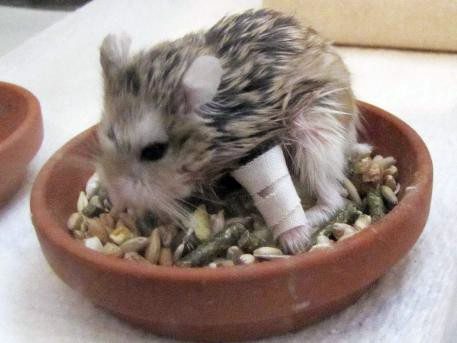
Veterinary help
Contacting a specialist will help you understand what to do if a hamster has a broken paw. The doctor may prescribe painkillers (meloxicam) for 1-3 days to prevent pain shock. Then, depending on the nature of the injury, the surgeon will prescribe rest or amputation of the injured limb.
No need to ask the doctor to “save the limb at all costs.” Hamsters and other animals can lead a full life on three legs. If the hind leg is damaged, amputation is more favorable: there are cases when the hamster lived for a long time and was active in the absence of both hind legs. The operation is performed under general anesthesia, for hamsters local anesthetics (lidocaine) are deadly. The safest is gas (inhalation) anesthesia (isoflurane, sevoflurane), it is impossible to overdose it. Timely intervention allows you to form a neat stump, avoid necrosis and sepsis. Complications associated with suture chewing are possible, but they are rare.
A broken paw in a hamster is a great grief for the owner, but the right actions in such a situation will help the pet survive the injury and recover.
Paw fractures: symptoms, diagnosis and treatment
3.1 (61.03%) 155 votes





